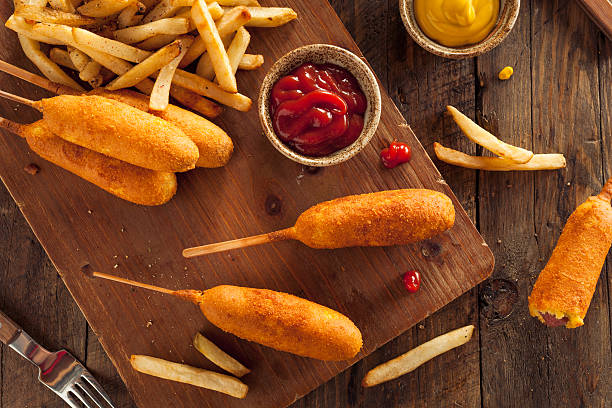If you’ve never watched a teenager rope a steer while casually sipping an ice cream float, you’re missing out on a quintessential rodeo experience. These centuries-old events, celebrated not only in the United States but also across Mexico, Canada, Brazil, and beyond, offer a blend of thrilling competitions and diverse culinary delights. Rodeo cuisine is far more than just carnival classics like corn dogs; it’s a journey into the regional flavors and local food scenes of the host communities.
A Diverse Culinary Landscape
Rodeos come in all shapes and sizes, from intimate farmstead gatherings to high-tech stadium extravaganzas. Similarly, the food at rodeos reflects the local tastes, demographics, and agriculture of the regions they call home. While you can certainly find typical fairground fare like corn dogs or deep-fried Oreos, rodeos often serve as windows into the culinary traditions of their host communities.
- Denver Powwows: In the heart of Denver, you can savor piping-hot frybread at local rodeos, a delicious treat that pays homage to Native American culinary heritage.
- South Texas Rodeos: Down in South Texas, rodeo-goers can enjoy a fusion of boba tea and elote, a popular Mexican street food dish made from corn.
- Montana Roundups: In rural Montana, burgers take center stage at rodeos, often topped with homegrown huckleberry barbecue sauce, showcasing the region’s natural bounty.
Much like a fine wine or a rare truffle, rodeo cuisine is inextricably linked to its place of origin. It’s a unique opportunity for curious travelers and proud locals to connect with the flavors of their communities.
From Cowboy Grub to Culinary Extravaganza
The history of rodeo cuisine traces back to what historian Richard C. Rattenbury aptly describes as “cowboy grub.” In the 19th century, ranching in the rugged terrain of what we now call Mexico and the United States involved a lot of downtime for cowboys and vaqueros. To pass the time, they created impromptu competitions to showcase their skills in saddle-bronc riding, steer roping, and calf roping. These contests had few rules, no arenas, and certainly no prizes, and if anyone ate while watching, it would have been a simple menu of beans, salt pork, dried fruit, black coffee, and other shelf-stable road snacks.
Thankfully, much has changed since the 1800s, both in terms of how rodeos are organized and how they are catered. Today, rodeos like the Houston Rodeo in Texas offer an expansive culinary experience that rivals some of the best food festivals in the country. Esteemed city restaurants like Goode Company BBQ, El Patio, and Pappas Steakhouse often set up stands, as do Texas wineries and local food entrepreneurs.
The Houston Rodeo Experience
The Houston Rodeo, in particular, stands out for its focus on local flavors and vendors. Texas’ cattle industry takes center stage, with beef playing a prominent role in the menu. However, the rodeo also embraces innovation and diversity. For example, in 2022, attendees could sample deep-fried jambalaya rolls, paying tribute to the city’s sizable population with roots in Louisiana.
As Emma Balter, the food editor of Chron, a sister site to the Houston Chronicle, points out, “It’s a good reflection and representation of the city and what we offer as a diverse community, not just of eaters, but of business owners and restaurateurs.” Houston, the fourth-largest metropolis in the United States, boasts a dynamic food scene that includes everything from barbecue to Tex-Mex to Vietnamese cuisine. For a hungry traveler, a visit to the Houston Rodeo means experiencing the rich tapestry of Texas cuisine in just one day.
Celebrating Local Agriculture
Smaller rodeos may not offer the same volume or variety of foods, but they share the same commitment to reflecting their local communities. Many of these rodeos double as livestock shows, where young farmers and 4-H Club members proudly present the animals they’ve raised. This focus on local agriculture influences what is served at rodeos, with milkshakes from nearby dairy farms and beef from cattle ranches just a short distance away making their way onto the menu.
This emphasis on local agriculture is an essential part of the rodeo experience, highlighting the connection between food and the communities it sustains. In regions where people live miles apart from their nearest neighbors, rodeos serve as community hubs. Rodeos like the one in Wilsall, Montana, a town with fewer than 300 year-round residents, play a crucial role in bringing people together.
Community and Culinary Diversity
While it might seem unusual to admire a Future Farmer of America’s prized calf while vendors sell burgers nearby, it’s a testament to the realities of life in cattle country. Dining at the rodeo encourages us to consider what “eating local” truly means in these agricultural communities. As Mackenzie Filson, a freelance digital food producer for Delish and former ranch worker in Montana, explains, “There’s a lot of pride in raising cattle, and people really feel a connection to the livestock.”
Moreover, in areas where people are scattered across vast landscapes, and urban environments are dissected by highways, rodeos serve as vital social gatherings. They bring together friends and families, fostering a sense of community that transcends the physical distance between residents. These events are a modern-day evolution of the campfire gatherings of cowboys and vaqueros from centuries past.
Whether you’re indulging in deep-fried jambalaya rolls at the Houston Rodeo or savoring a burger topped with huckleberry barbecue sauce in rural Montana, rodeo cuisine offers a unique culinary journey that celebrates local flavors and brings communities together. So, the next time you find yourself near a rodeo, don’t miss the opportunity to explore the diverse world of rodeo food and experience the flavors of the region like a true local.
